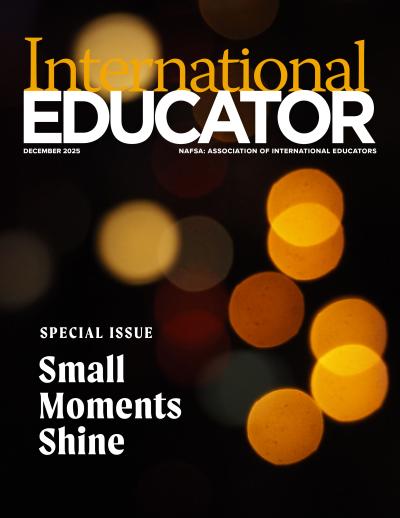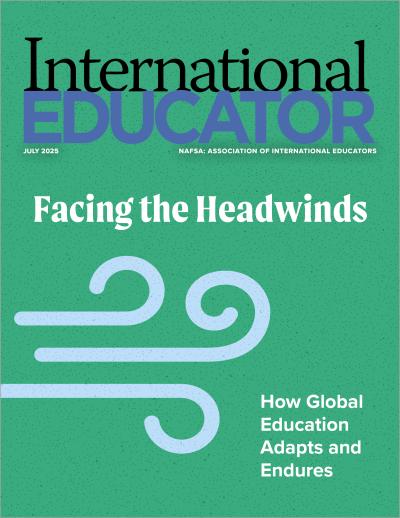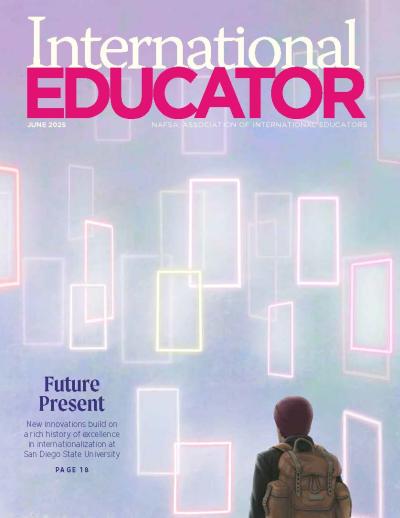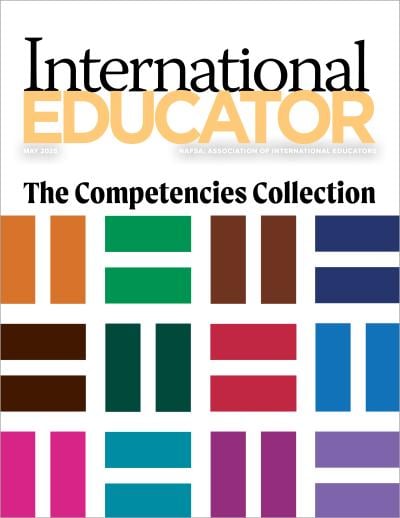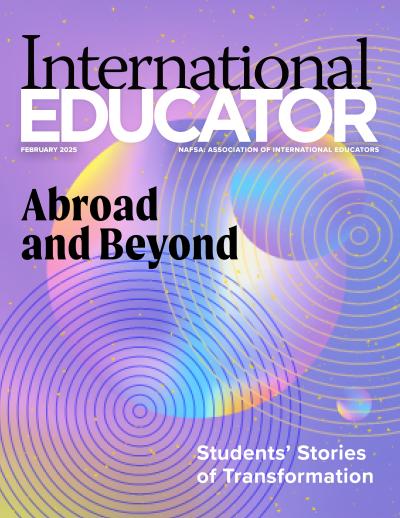Partnerships 101
Fairy godmothers. Opportunity spotters. Academic diplomats.
These are just a few of the ways international educators who are charged with managing their institutions’ global partnerships describe themselves. And while their roles vary from leading a team dedicated to global partnerships to finding ways to build them in one-person offices, these professionals are managing an increasingly important part of international education—which has become a growth opportunity at a time of uncertainty and limited resources.
“I’m seeing headwinds in a lot of places in international education, but I’m seeing tailwinds with partnerships,” says Sarah Olson, director of global partnerships at the University of California-Davis. “There are amazing opportunities for your institutions, but also limitations if you don’t manage those partnerships well.”
At a time of transition in international offices and for the staff who oversee them, understanding how to get partnerships off the ground has become one of the top questions in the field—both in the United States and around the world. “Partnerships seem to be very much on people’s radar,” says Krista Northup, director for global partnerships at the University of North Carolina-Chapel Hill (UNC).
“In the partnerships role, you have to be internally and externally engaged.” —Sarah Olson
What follows is an introduction to partnerships, featuring advice from a global group of international educators whose careers are dedicated to building these relationships—and maintaining them as the sector continues to evolve.
A Partnership Primer
From faculty research collaborations and scholar exchanges to student mobility and joint degree programs, international education partnerships vary widely. While some collaborations start within the international office, many originate from one-on-one relationships between faculty members or scholars and grow over time into larger efforts that go beyond the initial research project or visit over time.
Partnerships have long been seen as a way to accelerate internationalization efforts and provide new opportunities for faculty and students, but the focus has largely shifted from breadth to depth in recent years.
“There was a time in international education when people were proud to have 300 memoranda of understanding,” says Douglas Proctor, incoming assistant vice president of global engagement and partnerships at York University in Toronto and faculty member for NAFSA’s e-Institute. “We’ve left that time behind. As an institution and a person driving partnerships, you need to know the ‘why’—the whole question of purpose and intent.”
“There was a time in international education when people were proud to have 300 memoranda of understanding. We’ve left that time behind.” —Douglas Proctor
This holds true for institutions in the United States and around the world. At the University of Mannheim in Germany, for example, an earlier focus on growing the portfolio of international partnerships matured in the second half of the 2010s. “We’re still open to expand, but we want to focus on quality over quantity,” says Lukas Dausend, team lead of study abroad programs.
That shift has been accelerated by recent challenges, including tighter budgets and thornier compliance issues. Today, managing partnerships involves a growing number of internal and external stakeholders, understanding institutional objectives, and recognizing where ambition, capacity, and alignment intersect to make joint ventures effective.
“In the partnerships role, you have to be internally and externally engaged,” Olson says. “You have to know the players, and you have to know the partners.”
Get Oriented
Start with institutional priorities.
Partnership professionals—and especially those new to partnerships or an institution—should begin by familiarizing themselves with the institution’s strategic plan, mission, or goals to understand overarching priorities. Many institutions explicitly include international or global initiatives in their strategic plans, but the broader objectives also offer hints about what’s important to senior leaders. “That can be very different depending on size, profile, and the leadership of the institution,” Northup says. “Being intentional and clear about what the institution is trying to achieve is the starting point.”
Layer in the international office’s priorities.
After getting a clear sense of institutional priorities, understanding the regions or areas of study targeted by existing international programs or partnerships is key, as are the senior leader’s priorities. “The senior international officer and the partnerships person really have to be in lockstep,” Olson says.
Beginning with this deep dive should help identify “what you want and what you’re good at,” Dausend says.
Build the Internal Network
A critical early step can simply be described as “getting to know people on campus,” as Olson puts it. There are two steps to this process, which can be done in tandem: building personal relationships and mapping existing connections.
Meet with and map key stakeholders.
Connect with faculty leaders of each college or department or faculty to understand where their interests may lie as well as to catalog any existing research or exchange collaborations. It’s also important to build relationships with key players to partnership activity across the institution, including the legal department, research and export control administrators, registrars and admissions officers, student affairs staff, and others. “Get your own support network in place,” Dausend advises.
Determine who can initiate partnerships.
Understand the institution’s policies or past practices around who can initiate and sign partnership agreements, which can be highly decentralized, especially in the United States, Proctor says.
A deeper understanding of relationships across campus will prove critical as partnership work begins. “I think back to the start of UNC’s institution-wide partnerships and can draw a personal connection to all of them,” Northup says.
Assess Capacity
Before initiating partnership conversations, it’s important to understand what the institution brings to the table for prospective partners. “It’s not always clear what you can and can’t do. If you don’t know, it can make the process really complicated,” Olson argues.
Determine what’s needed for different kinds of partnerships.
Even basic partnerships rely on institutional capacity—for example, professor visits or research partnerships involve protocols for receiving visiting scholars, while more complex partnerships that involve student mobility require understanding whether an institution has the structures and supports within the international office and with campus partners, like housing and student affairs. Requests for dual degrees or pathway programs require navigating even more complex institutional policies around tuition, costs, credit and not-for-credit programs.
Develop a factsheet for prospective partners.
Prepared with information about the services available to partners, their students, and their scholars, partnership professionals can develop a factsheet for use with prospective partners outlining the “arguments about what makes your institution a good partner or destination,” Dausend says.
Find Partnership Opportunities
Newcomers to the field may be surprised to learn that partnership opportunities will often come to them. “Even if you do nothing, you’ll be approached,” Proctor says. “It’s always terribly tempting [to consider the] incredible stuff that’s going to happen. And it could!”
Even so, finding partners aligned with institutional priorities and capabilities often requires actively networking and nurturing internal and external relationships.
Network with potential partners.
Attending international education conferences like the NAFSA annual conference is key, as they are by design “hotbeds for collaborative activities,” Proctor says. The regular cadence of conferences also allows relationships to grow over time, which Dausend argues is critical to building “the trust necessary for partnerships, especially in the beginning.” Discipline-specific organizations, such as the American Political Science Association, represent another avenue for more targeted connections.
Remind stakeholders you’re here to help.
Meet regularly with academic departments and other stakeholders to gauge their needs. In these conversations, Olson describes herself as the “fairy godmother” of partnerships on her campus: “Tell me what you want, and I’ll try to make it so,” she says.
Look beyond institutional partners.
A wide range of organizations, including research agencies, industries, business associations, government initiatives, and diplomatic offices may have existing relationships with academics or staff—or present new opportunities.
Evaluate Prospective Partners
Among the questions to consider when evaluating specific partnership opportunities:
Does the partnership align with institutional priorities?
Along with strategic initiatives and objectives, don’t overlook regions or countries that are considered priorities—or, conversely, those more difficult to work in because of laws or institutional policies, such as the recent enactment of DEI bans at the state level that can complicate some kinds of partnerships. “There’s a geographic and programmatic lens,” says Proctor.
Is the partnership reciprocal?
Partnerships are generally win-win propositions, but institutions may perceive reciprocity in different ways, Olson cautions. In many cases, resources aren’t provided in equal measures because of different contexts, and it’s essential to ensure institutional leaders are comfortable with what their partner is bringing to the table.
Is there a collaborative advantage?
Put simply, the relationship should allow both partners to do things they couldn’t do without working with each other. Together, the partnership should allow for more than what a single institution could do alone.
Does the partnership have champions in both institutions?
Identify stakeholders on both sides of the partnership and ensure they are willing to participate throughout the lifespan of the relationship. For example, dedicated faculty champions in both partnering institutions are particularly important in many types of partnerships.
Have the required resources been secured?
The required resources must available at the time the partnership will take place This involves thinking through the needs of all participants, from academics and staff to students. For a student exchange partnership, for example, “try to put yourself in the shoes of a student who would go to that place,” Dausend suggests. “Pretend that you’re that student and ask all the questions they would have—and encourage your partners to ask the same questions about your institution.”
Do expectations align with the policy landscape?
For example, once-customary language in agreements around issues like diversity, equity, and inclusion may now present hurdles in jurisdictions where it is no longer allowed, Proctor cautions.
What if these questions lead to the wrong answers?
“It’s okay to say no, or not now, or not at the level of capacity they’re proposing,” Olson says. While this runs the risk of disappointing internal stakeholders, “being transparent about what you can and can’t do is always well received,” she adds.
Sustain and Maintain Partnerships
Signing a memorandum of understanding or partnership agreement is just the beginning, as partnerships must be sustained over time. There are several best practices to maintaining healthy, durable partnerships.
Establish regular touchpoints with your partners.
Periodic visits are critical to ensuring that partnerships are meeting the intended goals. “There’s an ongoing need to make sure you’re visible and get[ting] the latest information from a partner about their goals and challenges,” Northup says.
Different touch points may require different people. Senior leadership may be involved in signing agreements as well as key milestones and celebrations, while academic faculty partners are essential for many other conversations, such as those focused on about curriculum. “A really important function of the global partnerships office is pulling the right people together,” Northup says. It’s also helpful to create written summaries of formal visits or meetings to track progress and outcomes, she adds.
“A really important function of the global partnerships office is pulling the right people together.” —Krista Northup
But partnership professionals should also plan more regular, informal check-ins with their counterparts. “I’m a big fan of hopping on Zoom to talk about things,” Dausend says. “One of my pet peeves is people who hide behind generic email addresses and are never available. [A partnership is] a very symbiotic relationship, and something you have to nurture.”
Identify and track data to analyze performance.
Metrics are essential to monitor both individual partnerships and the institution’s overall partnership activity. The days of using the sheer volume of partnership activity as a measure of success are over—it’s essential to track other elements aligned with institutional goals, including student mobility statistics, information about countries and regions, grant or funding data, and more.
“You have to figure out the things that resonate for your institution to track so you’re not 10 years in or in a shifting landscape—like where we are now—where you have to justify why a partnership should continue,” Olson says. Northup agrees, noting the growing importance of metrics related to scholarship, including patents, research papers, and joint presentations. “Layering in [scholarly activities] as a measure of impact is an area we’re starting to work on more and more,” she says.
At the same time, “you can’t tell the story of partnerships only through data points,” Olson says. It’s important to collect stories from individual participants—students, scholars, and faculty members—to communicate impact.
Develop succession plans.
A successful partnership cannot be wholly contingent on one or two people and their personal affinity. Document who is involved in supporting each partnership and what their role is. Particularly for partnerships that were built around the interests of a specific faculty member, it’s also important to identify potential successors who will lead the partnership after the initial parties have moved on, Olson says.
Prepare for—and Manage—Growth
The biggest challenge partnership professionals face is growing their partnership portfolio too quickly or outstripping their capacity to manage it. “It can be a real challenge to stay focused,” Northup says. “Sometimes things start to come at you at all angles.”
Keep the focus on institutional priorities.
“You’re going to have to navigate through some strong feelings from people who are really focused on their thing,” Olson says. “You have to understand what your institution’s priorities are, … be the gatekeeper, and navigate through disappointing some people because their individual priorities may not align.”
Understand the impact on capacity as partnerships mature.
While most partnerships begin with a narrow focus, they often grow over time. For example, student exchange may spark faculty interest in research collaborations as well as formal dual degree or pathway programs as student numbers grow.
“We like to think partnerships sit in a nice square box,” Proctor says, “but you have to know how the things you do might fold into other areas. People shy away from these multilayered partnerships because they’re more complex, but they’re richer and give far more opportunity for [desired] outcomes.”
That requires constantly considering how to support faculty, staff, and other stakeholders as needs evolve. For narrowly focused partnerships, the partnership professional often serves primarily as a point of contact to help stakeholders navigate institutional rules and procedures. But as partnerships become more comprehensive, they often require coordinated oversight by the partnership lead. But, Olson cautions, each person’s ability to do so is finite.
“We like to think partnerships sit in a nice square box, but you have to know how the things you do might fold into other areas.” —Douglas Proctor
Olson estimates that she has the capacity to manage six comprehensive partnerships on her own—other leaders, she says, may be able to manage more or fewer, but the capacity question is the same.
“You can’t be the director of partnerships for all of them,” Olson says. Partner with institutional champions in different academic departments or other stakeholders to offload management of less complex partnerships. When delegation of management is needed, establish a clear point of contact, plan for each one, and connect with all stakeholders regularly.
Recognize that all partnerships evolve—and sometimes run their course.
While some partnerships mature in ways that require increasing levels of resources and attention, others may reach a clear endpoint, become too complex to manage, or face diminishing returns. “You have to be open to wherever the partnership stands,” Olson says. While conversations about curtailing partnerships that have run their course can be difficult, it is better to be truthful than leave partners hanging in the wind with non-responsiveness.
Build Capacity for the Long Haul
While managing their portfolios, partnership professionals must also develop systems that can help the institution manage them more effectively over time.
Create internal tools.
Along with the metrics described above, it’s essential to develop systems to ensure partnership information is readily available and can be analyzed. “Data in the international space is greatly undervalued,” says Kirsten Feddersen, vice president of partnerships for IDP Education.
While these systems can be as simple as common naming conventions and data points in spreadsheets or databases, new technologies such as artificial intelligence can be harnessed to manage and analyze the growing flow of information. “We’re going to have to learn how to use new tools,” Olson says.
Build your personal capacity through collaboration.
Managing global partnerships is a role for no more than a handful of people at an institution—or part of the job for the leader of a one-person office. In either case, it’s vital to collaborate with and learn from peers at similar institutions. To that end, Olson and Stacy Burger, director of global partnerships and strategic initiatives at Lehigh University, cofounded a community of practice for partnerships professionals.
Create systems to help stakeholders evaluate partnership agreements.
Especially at institutions where there’s decentralized authority to enter partnerships, there’s a need to create systems to help stakeholders such as faculty members weigh opportunities against capacity, according to Northup. “It can be very helpful to have internal structures and understanding in place to manage partnerships … from the start of the discussion to the signing of an agreement,” she says.
Even within the international office, such systems can help address the issue of “more requests for partnerships than time to assess,” Proctor says. At his previous institution, Australia’s Swinburne University of Technology, a series of templates outline factors for assessing both external partnership requests and ones identified internally.
Create ways to reach across the institution.
At UNC, for example, a council made up of representatives of each school and other departments meets monthly to share developments. “It’s a really great way to build internal support … and get feedback from what constituents are doing with their global partnerships,” Northup says. The office also provides global partnership awards and seed funding to recognize faculty efforts.
Even in the absence of formal programs, it’s important to “be a known entity on campus,” Olson recommends.
Remember the importance of the role.
Whether you think of yourself as an academic diplomat, opportunity spotter, or fairy godmother, stay open to new opportunities for your institution and its faculty, students, and scholars.
“This area of international education is still evolving and will continue to do so,” Olson says. “It’s exciting to be in partnerships right now—it’s such an amazing aspect of international education that I can’t imagine doing anything else.” •
NAFSA Resources
- NAFSA’s Guide to International Partnerships: Developing Sustainable Academic Collaborations
- NAFSA Executive Internationalization Leadership e-Institute "Developing Sustainable Global Partnerships" module
About International Educator
International Educator is NAFSA’s flagship publication and has been published continually since 1990. As a record of the association and the field of international education, IE includes articles on a variety of topics, trends, and issues facing NAFSA members and their work.
From in-depth features to interviews with thought leaders and columns tailored to NAFSA’s knowledge communities, IE provides must-read context and analysis to those working around the globe to advance international education and exchange.
About NAFSA
NAFSA: Association of International Educators is the world's largest nonprofit association dedicated to international education and exchange. NAFSA serves the needs of more than 10,000 members and international educators worldwide at more than 3,500 institutions, in over 150 countries.
NAFSA membership provides you with unmatched access to best-in-class programs, critical updates, and resources to professionalize your practice. Members gain unrivaled opportunities to partner with experienced international education leaders.





